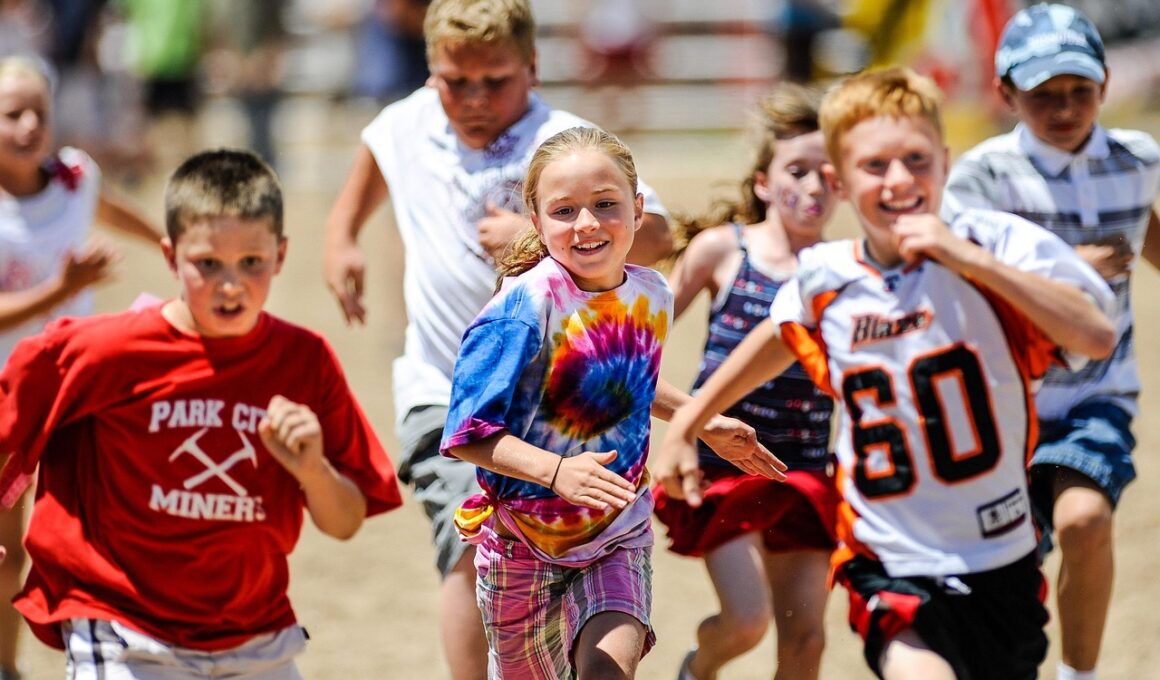The Best Warm Weather Running Tips for Kids
Warm weather can be exhilarating for children who love running, but it comes with its own set of challenges. Parents should ensure their kids stay hydrated, as dehydration can lead to reduced performance and health risks. Offering kids small water bottles to sip periodically during runs is a fantastic way to encourage hydration. Adjusting running times is also essential; consider scheduling runs in the cooler parts of the day, like early morning or late afternoon. Discussing dress with children is vital, particularly wearing breathable, light-colored fabrics that allow air circulation. Sunscreen is a must-have to protect sensitive skin from harmful UV rays. To make running more enjoyable, incorporate fun running games or obstacles. These distractions can keep kids motivated and energized for longer periods. Pairing runs with good nutrition is crucial for sustaining energy, including giving them fun snacks post-run. Lastly, celebrate their achievements, no matter how small; this can enhance their love for running and encourage them to continue in a positive manner. Keeping these tips in mind will ensure that kids enjoy their warm-weather runs safely and healthily.
As the temperature rises, so do the challenges of running for youngsters. One important aspect is proper hydration before, during, and after the activity. Encourage children to drink water even when they don’t feel thirsty, as kids may not always recognize their hydration needs. You can make hydration more appealing by adding slices of fruit to water bottles. Educating them about their bodies will further their interest in staying healthy. Moreover, promote a gradual increase in activity levels to avoid injury. Involving kids in a structured program can yield significant benefits and help them develop proper running mechanics. Reminders to listen to their bodies and stop if they feel dizzy or overly tired is essential to prevent heat exhaustion. Additionally, plan for cooler locations, such as shaded parks or tracks, where kids can run and cool off. It’s essential to keep an eye on the weather as well since running in extreme heat isn’t wise. Kids thrive on routine, so incorporating consistent running times can encourage regular participation and build a habit of fitness from a young age, shaping healthier futures.
Building a Fun Running Environment
Creating a positive running environment can significantly influence a child’s desire to participate in running activities. Encouraging children to run with their friends not only boosts motivation but also makes the experience more enjoyable. You can organize family runs or neighborhood running groups where kids can socialize while exercising. Collaborating with local schools or community centers can also enhance participation, as children thrive in a connected community atmosphere. Introducing challenges like running clubs or fun races can foster a sense of achievement and camaraderie among them. Reward systems, such as earning badges or prizes for participation, motivate children to commit to their running routine. Integrating technology, like running apps designed for kids, can gamify their running experience. Providing opportunities for children to share their running experiences on a family blog or social media can help them feel a part of a lively running community. In conclusion, the emphasis should be on fun and engagement rather than competition, thereby eliminating any pressure, creating a wholesome and enjoyable running culture for children.
Another critical factor in running safely during warm weather is appropriate clothing. Select lightweight, moisture-wicking fabrics that allows kids to stay cool and dry during their runs. Suggest that they wear hats or visors to shield their eyes from direct sunlight. Teaching them about the importance of proper footwear is also vital. Shoes should offer adequate support while being comfortable enough to avoid blisters. Consider organizing shoe fitting events with local running stores where children can learn about finding the right pair. Encourage them to pay attention to their body alignment and running form. This understanding helps prevent injuries and enhances running efficiency. Pairing running with stretching exercises, both before and after, can further minimize injury risks. Introduce simple dynamic stretches in warm-ups followed by static stretching afterward to promote flexibility and recovery. Children should also understand the signals their bodies send; recognizing fatigue or pain early is crucial for their running development. Ultimately, instilling good habits early on will help kids develop a lifelong love for running while keeping health-related issues at bay.
Nutrition Matters for Young Runners
Nutrition plays a significant role in children’s running performance and health. Providing a balanced diet rich in carbohydrates, proteins, and healthy fats will fuel their bodies for optimal running. Encourage children to have a nutritious pre-run snack, choosing options such as bananas or granola bars. Post-run meals are equally important for recovery; consider foods like yogurt, smoothies, or whole-grain sandwiches. Engaging kids in meal planning can make healthy eating fun and educational. Teach them the importance of eating a variety of colors on their plates to ensure they receive adequate vitamins and minerals. Involving them in cooking can increase their interest in healthy foods. Discussing portion sizes and the importance of eating before activity will help shape their understanding of nutrition. Ensure they maintain energy levels throughout running activities by sampling healthy options during long runs. Ignoring nutrition can result in fatigue and lackluster performance. By highlighting the connection between food and energy, you can create a positive relationship with food for your kids while bolstering their running prowess and overall health.
Promoting mental well-being is also crucial for kids engaged in running programs. Encourage them to set personal goals, whether it’s running a certain distance or improving their speed. This practice builds focus and determination, essential traits in any sport. Practicing mindfulness before a run can also decrease anxiety and boost performance; this method helps kids connect their breath with their movements. Introducing warm-up routines that include mental imagery techniques can help calm nerves and enhance their enjoyment of running. Parents should promote resilience by reinforcing the idea that not every run needs to be perfect. Positive reinforcement is key; highlight their progress and improvements, creating a supportive environment. Discussing the feelings that arise during running can provide children vital coping mechanisms, teaching them to acknowledge discomfort rather than shy away from it. Scheduling regular reflections on their experiences can emphasize the fun aspects of running while alleviating stressful feelings. Engaging them in discussions about the benefits of physical activity for both mind and body helps reinforce their connection to a healthier lifestyle and lifelong enjoyment of running.
Keeping Kids Safe This Summer
Ensuring safety is paramount when children engage in outdoor running during summer. Parents must be vigilant about monitoring for signs of heat-related illnesses, such as heat exhaustion or heat stroke. Educate kids on recognizing symptoms like dizziness, excessive sweating, and nausea. Plan and communicate proper rest intervals between runs; this could extend running time while easing fatigue. Running with a buddy system can also enhance safety during outdoor sessions. Always remain aware of your surroundings, ensuring kids remain on known trails or safe locations away from traffic. Harness the power of technology by providing them with devices like smartphones for emergencies. Setting up a check-in system, either with parents or coaches, ensures their continued connectivity. Furthermore, sun safety can’t be overlooked, applying broad-spectrum sunscreen regularly to protect delicate skin. Scheduling regular breaks in shaded areas can help cool them off. Not to forget, ensuring kids know it’s acceptable to stop running if they feel uncomfortable can encourage a safe running environment. Ultimately, promoting a culture of safety will not only enhance their physical activity but also instill lifelong habits for outdoor enjoyment.
Finally, the importance of fun in kids’ running programs cannot be overlooked. Incorporating various activities can keep children engaged and motivated. Games like tag, relay races, and obstacle courses can be excellent for blending fun and running practice. Implementing themed runs, like a superhero or animal-themed event, can stimulate creativity and excitement. Celebrating milestones is a way to recognize their hard work and redefining the concept of competition. Organize seasonal events that engage families and the community, creating a supportive atmosphere that encourages participation. This all-inclusive spirit promotes camaraderie and forms friendships among participants. Keeping the mood light requires flexibility in the programs to adapt to children’s moods and energy levels. Always prioritize enjoyment over competitiveness; it is essential for sustained interest in running activities. Inquire about children’s preferences and include them in decision-making to increase their enthusiasm. When children enjoy running, they are more likely to continue the activities throughout their lives. Remember, fostering a positive, light-hearted environment will pave the way for healthy, happy children who grow up with a love for running.


